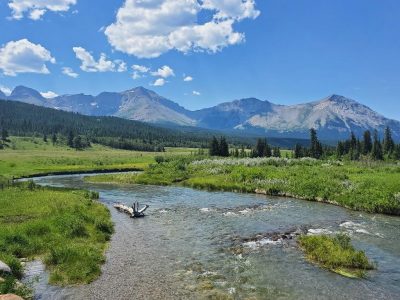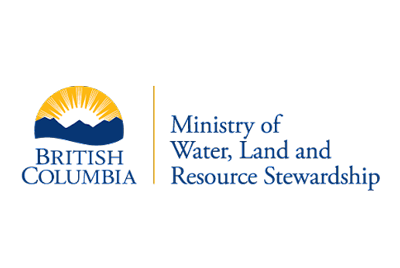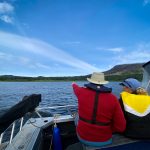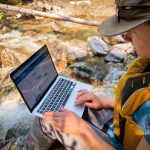Living Lakes Canada with the Oldman Watershed Council has launched a community-based aquatic monitoring program across the Eastern Slopes of the Rockies. Through this program, Living Lakes Canada is working with partners to assess local community needs, share expertise and resources, secure additional resources as required in order to develop a community-based water monitoring (CBWM) program for the Eastern Slopes. Partner organizations will continue to complete necessary training, identify local study objectives and sites, and collect data from streams using national CABIN sampling protocol and STREAM eDNA metabarcoding analysis. Living Lakes Canada also works to support the future development of a Canadian Aquatic Biomonitoring Network (CABIN) reference model for the Eastern Slopes that can be used for assessing test sites using the Reference Condition Approach.
BACKGROUND
Alberta’s Eastern Slopes form part of the headwaters of two of Canada’s major watersheds, or basins. The Eastern Slopes headwaters include the Peace and Athabasca that flow north into the Arctic Ocean, and the North and South Saskatchewan that flow east into Hudson Bay. The headwaters of the Rocky Mountains provide 90% of Alberta’s drinking and irrigation water, as well as providing water to the prairie provinces.
This increasingly busy landscape is facing pressure due to a multitude of human uses, including rural communities, forestry, mineral and energy extraction, cattle grazing, motorized recreation, hunting and fishing, horseback-riding, hiking, and RV camping.
To protect the headwaters of major rivers to the Canadian Prairies, a Coal Policy was established in 1976 with the goal of ensuring that there were appropriate regulatory and environmental protection measures in place before new coal projects were authorized. In June 2020, the Alberta Government rescinded the Coal Policy, which opened up sensitive habitat of the Eastern Slopes to international open pit coal mining bids. In February 2021 this move was reversed after public outcry, however, there is still insufficient baseline data to determine appropriate watershed and land -use planning nearly 45 years after the introduction of this policy.
All of these land uses will naturally have an impact on water quality and aquatic ecosystems; there is a need for more monitoring both to establish baseline conditions and to measure change. Aquatic monitoring by the provincial government varies according to budget and priorities. An opportunity exists for local organizations and volunteers to work together to develop a community-based water monitoring (CBWM) program to augment and complement government monitoring.
Community-based monitoring (CBM) programs are:
- Driven by local community needs and values;
- Nimble and flexible because they are coordinated by smaller organizations;
- Able to make data accessible to the community in a timely fashion;
- Fantastic experiential learning activities and skills training, and;
- Opportunities to engage and motivate local citizens.
CABIN & STREAM PROGRAMS
CABIN (Canadian Aquatic Biomonitoring Network) is “an aquatic biological and chemical monitoring program developed by Environment and Climate Change Canada for assessing freshwater ecosystems, primarily stream and river habitats. Trainees of CABIN gain access to a suite of web-accessible tools and resources, such as a national database of biological reference condition information, data management system, analytical software and reporting tools. CABIN training provides the tools necessary for users to conduct consistent, comparable and scientifically credible assessments of streams. Results provide rationale to direct policy and planning efforts. It is the most widely used biomonitoring protocol in Canada, applied by federal government agencies, provinces, territories, community groups and industry. Living Lakes Canada was one of the first non-government organizations certified to deliver CABIN field certification workshops.
The STREAM project is now in its second phase as a collaboration between Living Lakes Canada, Environment and Climate Change Canada, the Hajibabaei Lab, and the University of Guelph. The founding project included collaboration with the World Wildlife Fund-Canada (WWF-Canada) to provide training for community-based water monitoring groups across Canada according to data deficiencies using the WWF Watershed Reports. The STREAM project has a goal to use the CABIN methodology and DNA metabarcoding for a national community-based water monitoring project. DNA metabarcoding has the opportunity to analyze benthic samples collected by community-based water monitors faster, cheaper and more accurately. The University of Guelph received funding from Genome Canada to provide sample analysis free for 3 years for participating groups (2019-2021). The project continues to provide CBWM groups sample analysis in-kind with the support of various funders.
Visit the STREAM project page on our website.
PILOT PROJECT TIMELINE
Year 1 (2020-21):
- Program Development (meetings, gathered resources, confirmed funding, identified sites, study design)
- Acquired equipment
- Began identifying reference sites and collecting samples to contribute to building a reference model (GIS)
- Partners identified local test sites and study question(s)
- Sampling was conducted in the fall with COVID-29 safety protocols in place
- Delivered trainings:
Canmore, Alberta - this course was attended by representatives from the following:
-
- Ghost Watershed Alliance Society
- Parks Canada, Canadian Conservation Corps
- Aquality Environmental Consulting
- LimnoLogic Solutions
- Stantec
- University of Waterloo
- Bighill Creek Preservation Society
- University of Calgary students
Coleman Crowsnest Pass, Alberta - this course was attended by representatives from the following:
-
- Athabasca Watershed Council
- North Saskatchewan Watershed Alliance
- Oldman Watershed Council
- Kainai Nation (Blood Tribe)
- Elk River Alliance
Year 2 (2021-22):
- Continued verifying reference sites
- Sampled test sites and reference sites as resources allowed (Free eDNA analysis from University of Guelph STREAM project)
- Delivered training:
Rocky Mountain House, Alberta (Fall 2021) - this course was co-hosted with the North Saskatchewan Watershed Alliance.
-
- It was attended by other Alberta Watershed Planning and Advisory Councils, First Nations, and academia.
- This course also provided an opportunity for the Oldman Watershed Council to participate in the STREAM/CABIN Train-the-Trainer process by shadowing the Living Lakes Canada course.
Years 3+ (2022-):
- Field sampling. Analyzed existing data to date
- Assessed success/value of project to organizations
- Planned and secured resources for future of CBWM program
LOCATION
This project encompasses the eastern slopes and foothills of the Rocky Mountains in Alberta, including the headwaters of the Peace, Athabasca, Lesser Slave, North Saskatchewan, Red Deer, Bow, and Oldman Rivers. Exact sites to be sampled will be determined by local organizations according to their study objectives, local land uses, and capacity. fRi Research carried out a GIS exercise to identify possible Reference sites within the sub-basin watersheds. Local community groups can then select which reference sites would be appropriate and feasible to add to their existing monitoring programs to support the development and push towards the reference model.
PARTNERS
There are numerous local organizations who seek to improve the watershed through education, monitoring, planning, and action like restoration activities. These organizations are ideally positioned - with an ear to the ground and a network of connections - to lead local community monitoring efforts. This collaboration involves Watershed Planning and Advisory Councils (WPACs), Watershed Stewardship Groups, First Nations land managers, academia, environmental non-governmental organizations, research groups, and volunteers, with support from government and Living Lakes Canada.
Engaged Organizations:
- ABI Environmental
- Alberta Environment and Parks
- Athabasca Watershed Council
- Blood Tribe Land Management
- Bow River Basin Council
- City of Calgary
- Cows and Fish
- Elbow River Watershed Partnership
- Environment and Climate Change Canada
- fRI Research
- Ghost Watershed Alliance Society
- Lesser Slave Watershed Council
- Living Lakes Canada
- Livingstone Land Owners Association
- Mighty Peace Watershed Alliance
- North Saskatchewan Watershed Alliance
- Oldman Watershed Council
- Parks Canada
- Red Deer River Watershed Alliance
- University of Guelph
- University of Victoria
- University of Calgary

News and Updates
Wading into water concerns in the Bow Basin – Bow River Basin Council, Nov 21 2022
Who will clean it up? – Alberta put a pause on coal. But its footprint remains – CBC News, Aug 25 2022
What has (and hasn’t) changed for coal mining in Alberta – The Narwhal, Mar 9 2022
Teaching citizen scientists to hunt for ‘canary in the coal mine’ in Alberta’s rivers – The Narwhal, Aug 7 2021
Rocky Mountain Eastern Slopes Biomonitoring Project, Phase II – Alberta Ecotrust
Rocky Mountain Eastern Slopes Biomonitoring Project, Phase I – Alberta Ecotrust
For a complete list of news features, visit our In The News page!











